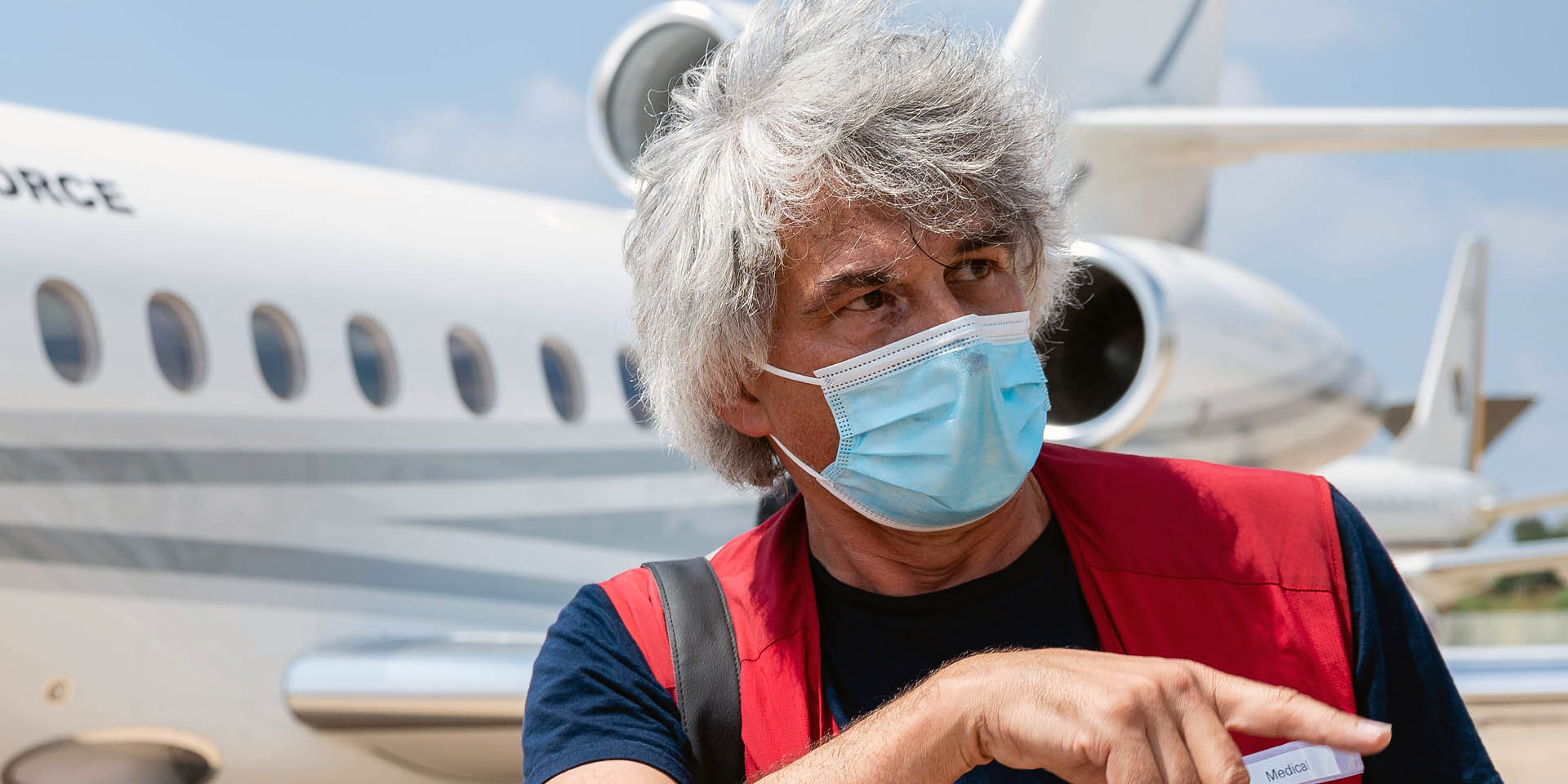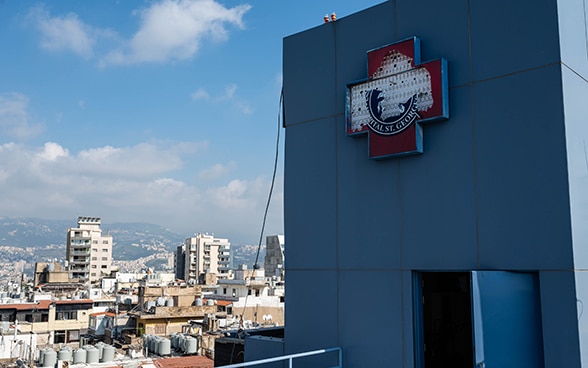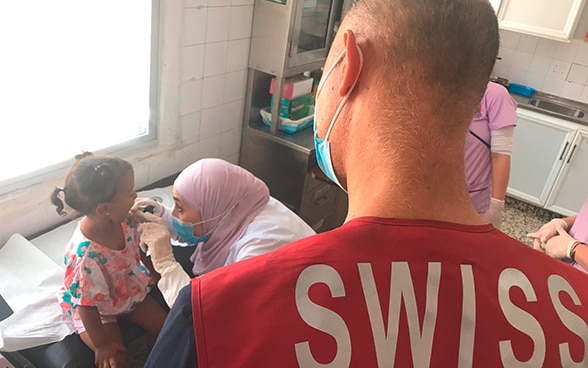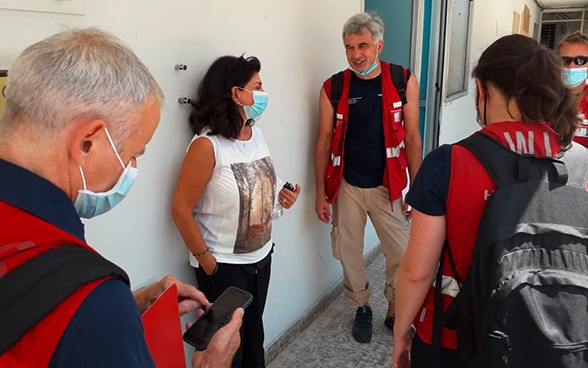”The relationships continue even after the return to Switzerland”
Several hospitals were damaged in the explosion in Beirut. Jean-Daniel Junod, a nurse anaesthetist from the Geneva University Hospitals, was part of the team specialising in mother and child medical care sent by the Swiss Humanitarian Aid. For Jean-Daniel Junod, the mother and child module's strength lies in working closely with local medical personnel. Support and assistance are what is needed to make a real difference in the long term.

To provide support in the area of health, the SHA Unit has sent several emergency aid teams to Beirut. One example is the "Mother and Child" module, which includes Jean-Daniel Junod © FDFA
The mother and child module was developed after the earthquake in Haiti in 2010, and was then used again one year later in Nepal, and now in Lebanon. It is a team of paediatricians, anaesthetists, obstetricians, midwives and nurses who operate on children and assist women about to give birth. Jean-Daniel Junod, what is the thinking behind the mother and child module?
The module was designed to go beyond the provision of emergency medical aid. We are able to get to the scene of a disaster and treat patients very quickly of course, but we are also more ambitious and seek to have an impact on the institutions. We have a complete medical team who can be mobilised quickly, along with equipment that can be transported by air or car. Our objective is to support a weakened institution and allow it to continue to operate during the crisis. That of course means working closely with our colleagues on the ground.
The module prioritises mothers and children, who are especially vulnerable during crises and are often overlooked because mother and child healthcare requires special expertise, but also for cultural reasons.
When you arrived in Beirut, how and why did you choose Saint George Hospital and Karantina Hospital to set up the mother and child module?
After visiting the affected hospitals in the area, we selected two: Karantina Hospital and Saint George Hospital. We based our response on actual needs and sought to access those worst affected, especially mothers and children. And lastly, we wanted to ensure that the project we were setting up was realistic and could be carried out successfully. Karantina Hospital is a public hospital that treats the poorest, but it was very badly damaged whereas the Saint George Hospital was able to get up and running more or less immediately. So we decided to launch a combined effort involving both hospitals, especially since we realised that they were already working together.

How did you make sure that the site was safe after such a big explosion?
We worked closely with SHA colleagues responsible for checking the structural integrity of the buildings and with the other Swiss teams. We were able to rely on the expertise of specialists in each field. There were the risks linked to the explosion, but we also had to contend with the heated protests in the city and the issue of COVID-19.
Your mission took place in different stages: what did you do for the hospitals?
In the first phase, the construction team rapidly repaired the premises of the Saint George Hospital so that we could start work as soon as possible. That was where we based the mother and child health module. We also started working in parallel at Karantina Hospital to set up a surgery, with a view to getting the hospital up and running again but also to start referring patients to Saint George Hospital. The colleagues of the construction team are also carrying out more extensive renovations at Karantina, which will last a few months.
A great deal of work has also been done with the Lebanese Ministry of Health, the management of the hospitals and the finance departments, which has resulted in agreements signed by the authorities. It was a very complex process that involved healthcare staff, engineers, architects, lawyers, and also diplomats. We did everything with our Lebanese colleagues, not for them. In the hospitals, we were there to support local medical teams. We provided them with practical support and equipment.

How many people are likely to benefit from the services of the mother and child module?
In the initial phase it can independently handle a hundred or so patients for up to five days, while additional resources are deployed in parallel according to needs. In Beirut we didn't set up a structure with a fixed capacity, we did much more: we helped weakened institutions to get back on their feet. Our job was not just to provide medical assistance to a few hundred people. And through these efforts, by lending visibility to a very fragile institution, we are making it stronger. Karantina isn't a profit-making institution – it's a public hospital, so it relies on public funds.

What was it like to work with local staff?
It was wonderful! We were impressed when we arrived to see armies of young people clearing the streets. It was the same in the hospitals. We met highly qualified personnel who were keen to help. That said, everyone was very shaken. The midwives at Saint George told me that almost all of them had difficulty sleeping, that they were in shock, anxious, and constantly on the alert. In these circumstances, the presence of staff from Switzerland was reassuring and provided some respite.
You've gained a lot of experience over the years during your missions in Haiti, Nepal, Indonesia and Libya. Did that help you in Lebanon?
Yes, of course. From our experience in other disaster areas, we know that we can very quickly help a hospital to become operational again. When we arrived, the timeline we were given was much longer than the time it actually took to achieve our goals. In that sense, it has been a great success, and has really made a difference to people's lives!
We have learned to integrate and to work together with our colleagues on the ground. That requires humility, tact and an ability to be pragmatic while continuing to provide world-class healthcare.
Do you stay in touch with local staff when you return to Switzerland?
The relationships we build on the ground continue even after the return to Switzerland. For example, following our experience in Gorkha in Nepal in 2015, we returned to provide practical training the following year with colleagues from the Geneva University Hospitals.
